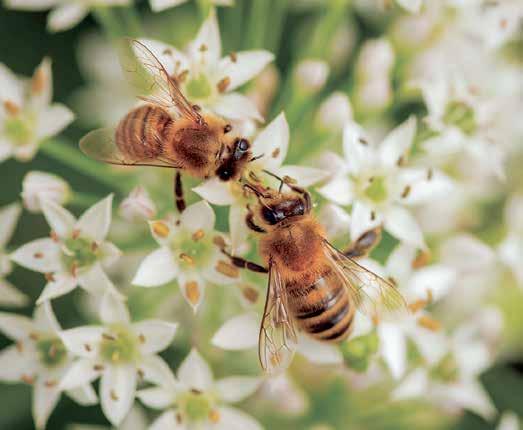
4 minute read
Springtime and honeybee swarms are around the corner
BY CHRISTEL HIXSON Hillcrest Farm, Elberta
Just as a new year is beginning for us human beings in this very different and somewhat unpredictable time of our lives, honeybee colonies here in the Southeast are beginning to build up population and their annual cycle of reproduction via swarming. Swarming is the honeybee colony reproduction and the main goal of every colony, whether it is living in a hollow tree, in a beekeeper’s stack of hive boxes in the backyard or in a new, old or abandoned structure.
Advertisement
Because of this natural instinct of reproduction, spring is a very exciting and busy time for beekeepers. Although we do not have much of a winter here in this part of the United States, honeybee colonies do slow down their foraging activities during winter as there are few blooming flowers for them to gather nectar and pollen. The queen therefore, does not lay as many eggs.
As daytime temperatures then begin to slowly climb, beekeepers start seeing more flight activity outside of their hives. Foraging bees begin transporting more and more pollen in their pollen baskets....yes, honey bees have little built-in baskets on their hindlegs for transporting pollen back to their hive to feed developing larvae in the broodnest. This is a sure sign that spring is right around the corner!
Now, as exciting as it may be to observe a colony in the act of swarming and settling on a tree branch or landscape structure, catching that swarm and successfully getting it into a hive box, beekeepers usually do not want to see their own hives swarm. This is because roughly half of the colony will leave with the “mother” queen and the other half of the original colony’s
population is left behind with a queen cell from which a new, young queen will soon emerge.
This usually happens when the beekeeper least needs them to as the spring buds are getting ready to burst open into beautiful blooms which provide the sweet nectar for the main honey production. For this reason, beekeepers are almost as busy as the bees implementing management techniques to try to prevent their colonies from swarming. However, as hard as they may try, bees can still outmaneuver beekeepers and swarm anyway!
This is where you, as part of the community and hopefully, as one who appreciates the fascinating and necessary existence of these creatures, will call a local beekeeper, county extension agent or local beekeeping club if you ever spot a colony of bees clustered somewhere they should not be.
Beekeepers who are interested in retrieving swarms usually put their names and contact information on a swarm removal list with their club. They will gladly collect swarms if easily accessible from a tree limb or landscape structure but often will charge a fee, especially if a colony has moved permanently into a gap or cavity in a building, for example, in a soffit or behind the wall of a building. When swarms take up residence in such places, it often requires a lot more time, effort and expertise to remove them safely and completely so that no trace of comb or scent is left behind to attract a future swarm.
A few good things to know about honey bee swarms is that when they are in that cluster, which can range from just a very small fist-size ball of bees to a much larger (think two to three times the size of a football) cluster, and when seen on a tree limb, shrub or maybe a fencepost, this is usually a temporary resting place.
Then the swarm begins complex decision-making that helps them locate and then travel to their new chosen home. The swarm can fly away within a few hours or possibly the following day. Also, these swarms are generally very docile as they have no “home” yet to defend.
It is still best to stay on the side of caution and keep a reasonable distance away. If possible, it is often helpful to snap a photo of the swarm to send to the beekeeper whom you can hopefully communicate with so that he or she can confirm that it is definitely a honey bee swarm and bring the correct size box and equipment in order to successfully capture the swarm.
If possible, try to observe the beekeeper collecting the swarm as it is an interesting and fascinating procedure! You might be surprised at how easily done it can often be. It may even trigger your curiosity so much that you may think about becoming a future beekeeper! This would be wonderful as there can never be enough beekeepers in the world.
Let’s look forward to springtime showers, bees and flowers!
The Baldwin County Beekeepers Association website includes a list of local beekeepers to contact for removing swarms: www.baldwinbees.com

Christel Hixson has been a beekeeper for six years at Hillcrest Farm in Elberta. You can contact her at 251-269-5642 with any beekeeping questions.





